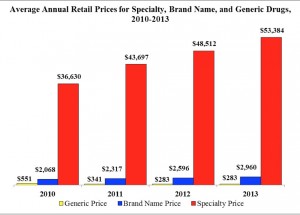 The average price for a specialty drug was $53,384 in 2013; the average household income was $52,250. Thus, even allocating 100% of a family’s annual earnings to pay for a drug wouldn’t stretch far enough to cover it in 2013, nor would it do so today in 2015.
The average price for a specialty drug was $53,384 in 2013; the average household income was $52,250. Thus, even allocating 100% of a family’s annual earnings to pay for a drug wouldn’t stretch far enough to cover it in 2013, nor would it do so today in 2015.
This sober health economic artifact comes from the latest Rx Price Watch Report from the AARP, detailing cost trends for prescription drugs across all segments — generics, brands and specialty drugs. Contrast, as well, the $53K for the average specialty drug with the median 2013 Social Security benefit payout of $15,526 and median Medicare member’s income at $23,500.
 Just last week, actress Pamela Anderson who has long managed Hepatitis C tweeted, “I am CURED!…I pray anyone living with Hep C can qualify or afford treatment. #dontlosehope.” Here she is pictured on Twitter with the complete tweet.
Just last week, actress Pamela Anderson who has long managed Hepatitis C tweeted, “I am CURED!…I pray anyone living with Hep C can qualify or afford treatment. #dontlosehope.” Here she is pictured on Twitter with the complete tweet.
Health Populi’s Hot Points: Value-Based Payments Require Valuing What Matters to Patients, asserts the title of a JAMA article published 13 October 2015, written by three health professionals: a physician, a public heath expert, and a heath policy expert, also a physician. There’s momentum at the FDA to move toward a more person/patient-centered regulatory regime, Patient-Focused Drug Development, where patients provide greater input into the Agency’s judgements and recommendations.
While Medicare still doesn’t negotiate for prescription drug prices, and employers aren’t leveraging their massive potential purchasing power vis-a-vis pharma and life science suppliers, consumers-as-payors have taken to media, both Old School and social media, to voice their concerns and outrage. Consider Pam Anderson, just one such very visible patient advocate.
 Pricing drugs “is not a science. It is a feel,” the former CEO of Genzyme was quoted as saying in the August 2015 issue of Health Affairs.
Pricing drugs “is not a science. It is a feel,” the former CEO of Genzyme was quoted as saying in the August 2015 issue of Health Affairs.
Consumers and Congress, along with payers, are coming together to seek more science and transparency for drug pricing. This plot is thickening in the advent of the 2016 Presidential election and consumers’ growing calls for price controls in healthcare — and in particular, over prescription drug prices.





 Interviewed live on BNN Bloomberg (Canada) on the market for GLP-1 drugs for weight loss and their impact on both the health care system and consumer goods and services -- notably, food, nutrition, retail health, gyms, and other sectors.
Interviewed live on BNN Bloomberg (Canada) on the market for GLP-1 drugs for weight loss and their impact on both the health care system and consumer goods and services -- notably, food, nutrition, retail health, gyms, and other sectors. Thank you, Feedspot, for
Thank you, Feedspot, for  As you may know, I have been splitting work- and living-time between the U.S. and the E.U., most recently living in and working from Brussels. In the month of September 2024, I'll be splitting time between London and other parts of the U.K., and Italy where I'll be working with clients on consumer health, self-care and home care focused on food-as-medicine, digital health, business and scenario planning for the future...
As you may know, I have been splitting work- and living-time between the U.S. and the E.U., most recently living in and working from Brussels. In the month of September 2024, I'll be splitting time between London and other parts of the U.K., and Italy where I'll be working with clients on consumer health, self-care and home care focused on food-as-medicine, digital health, business and scenario planning for the future...